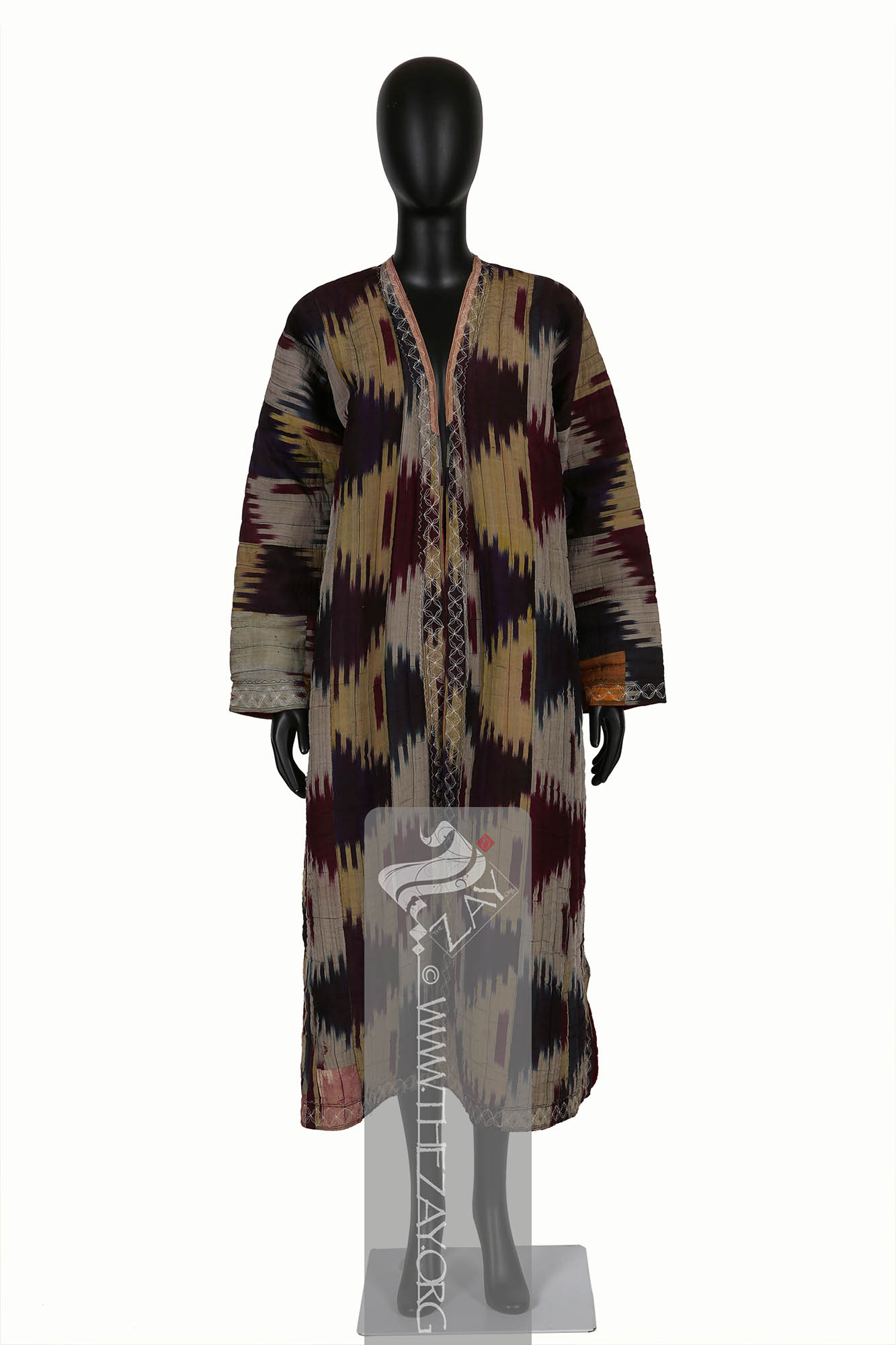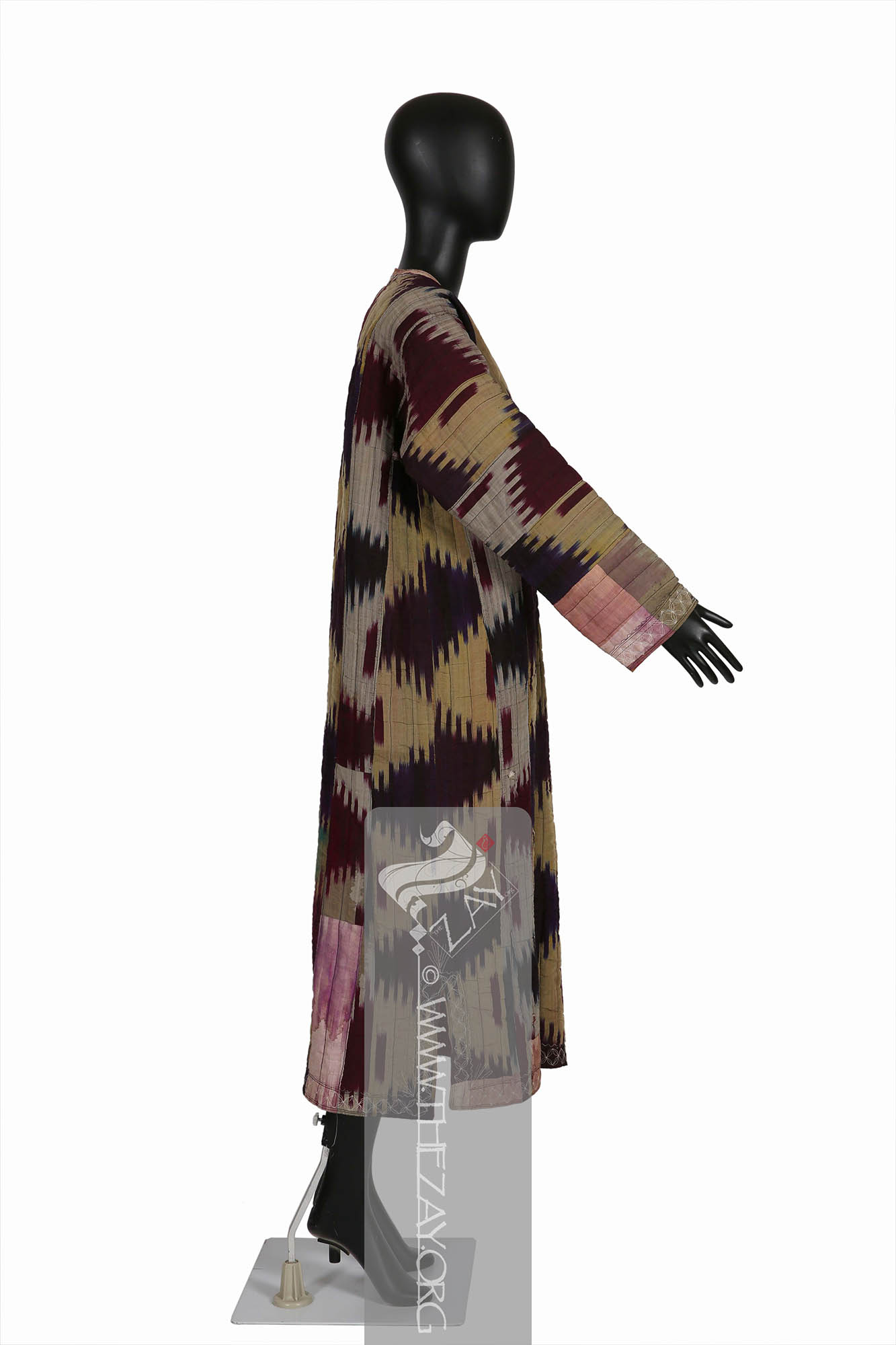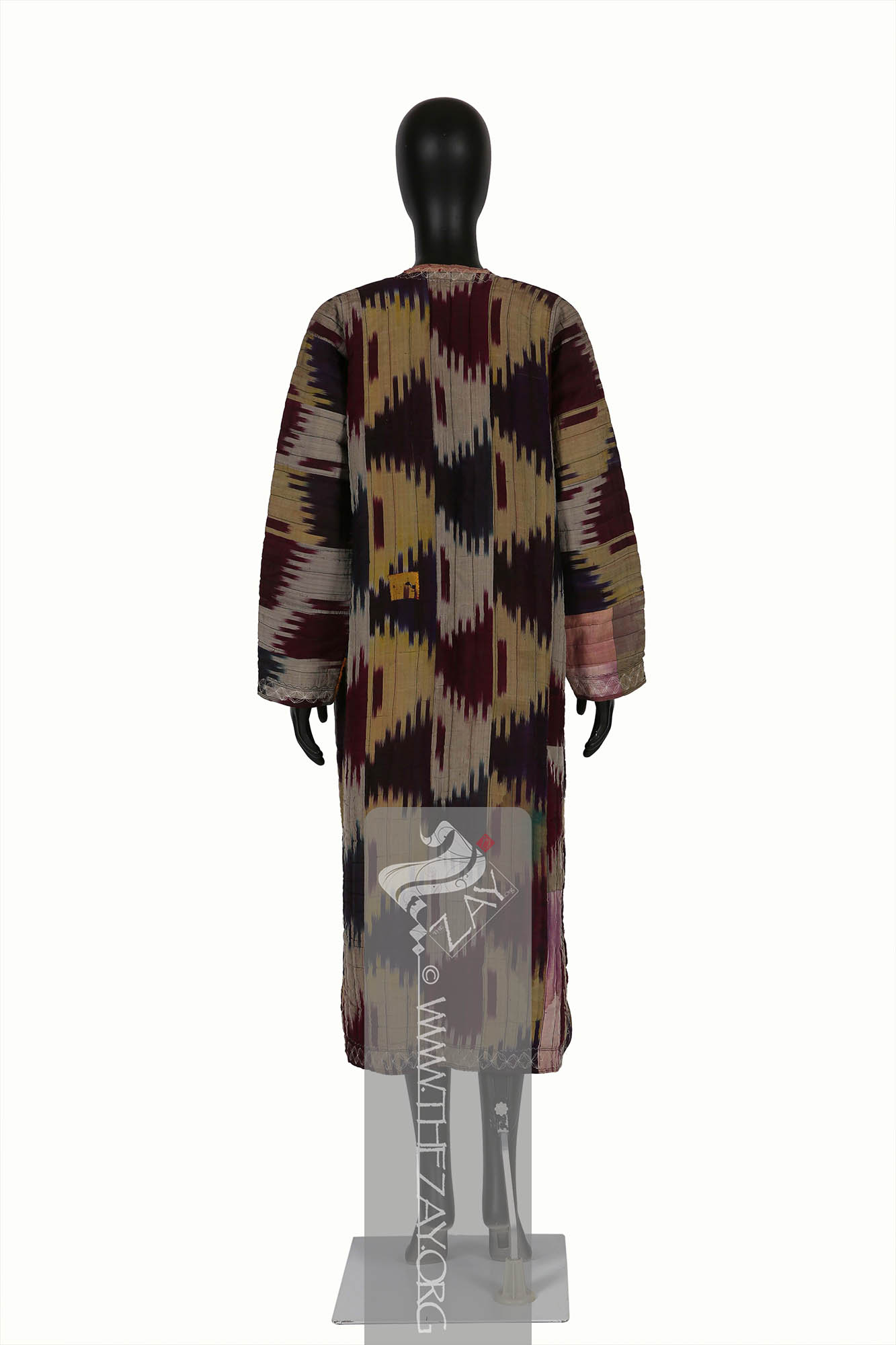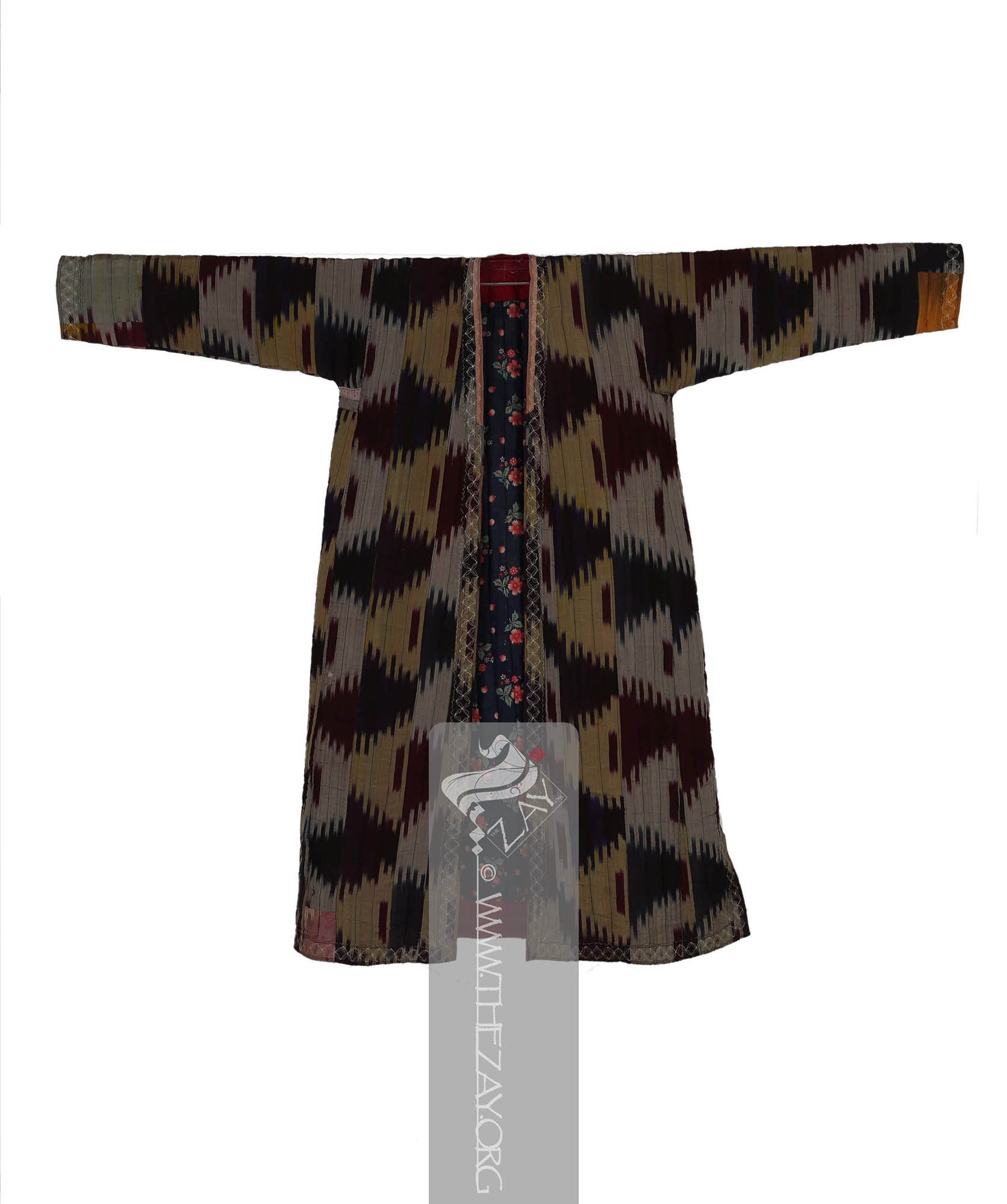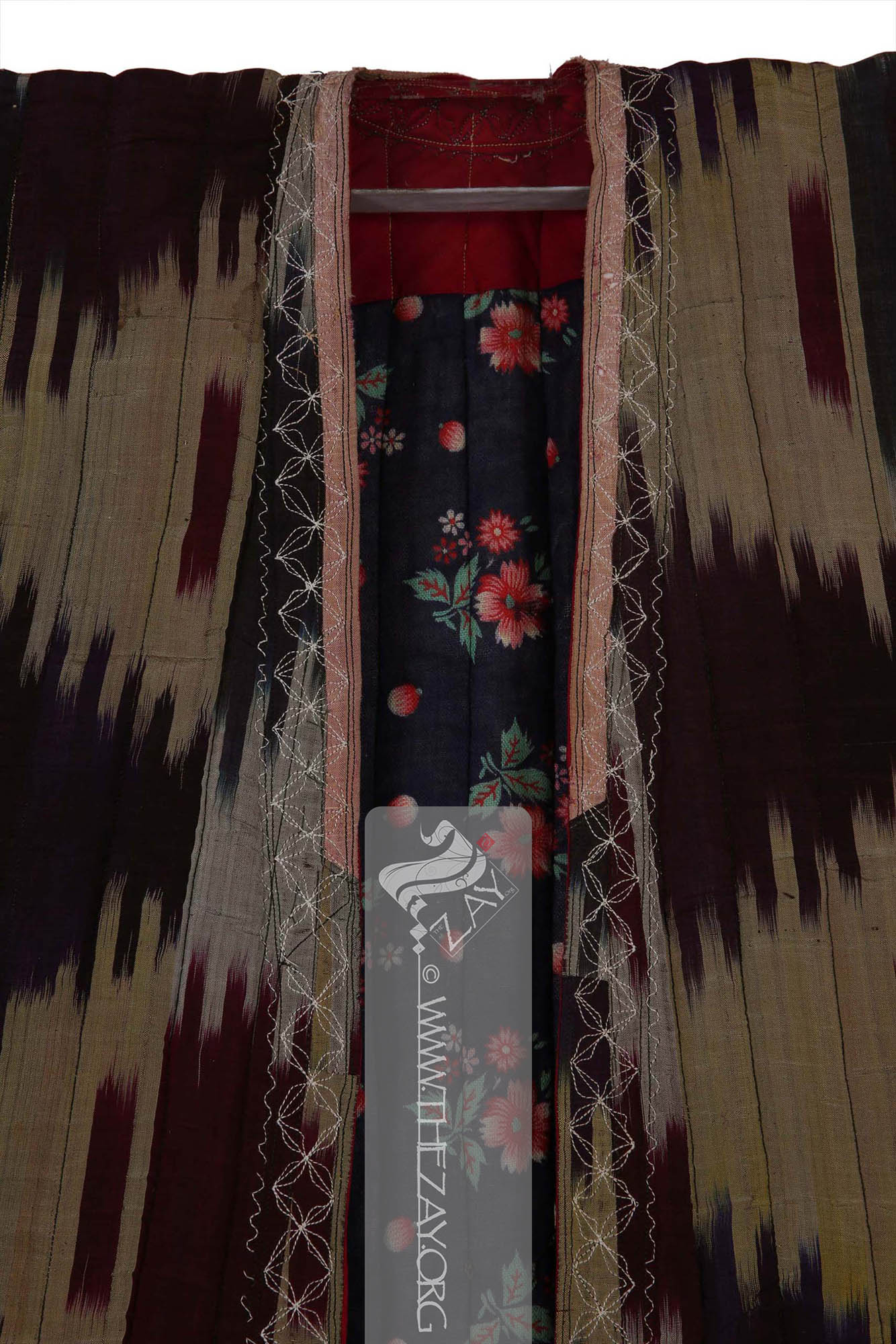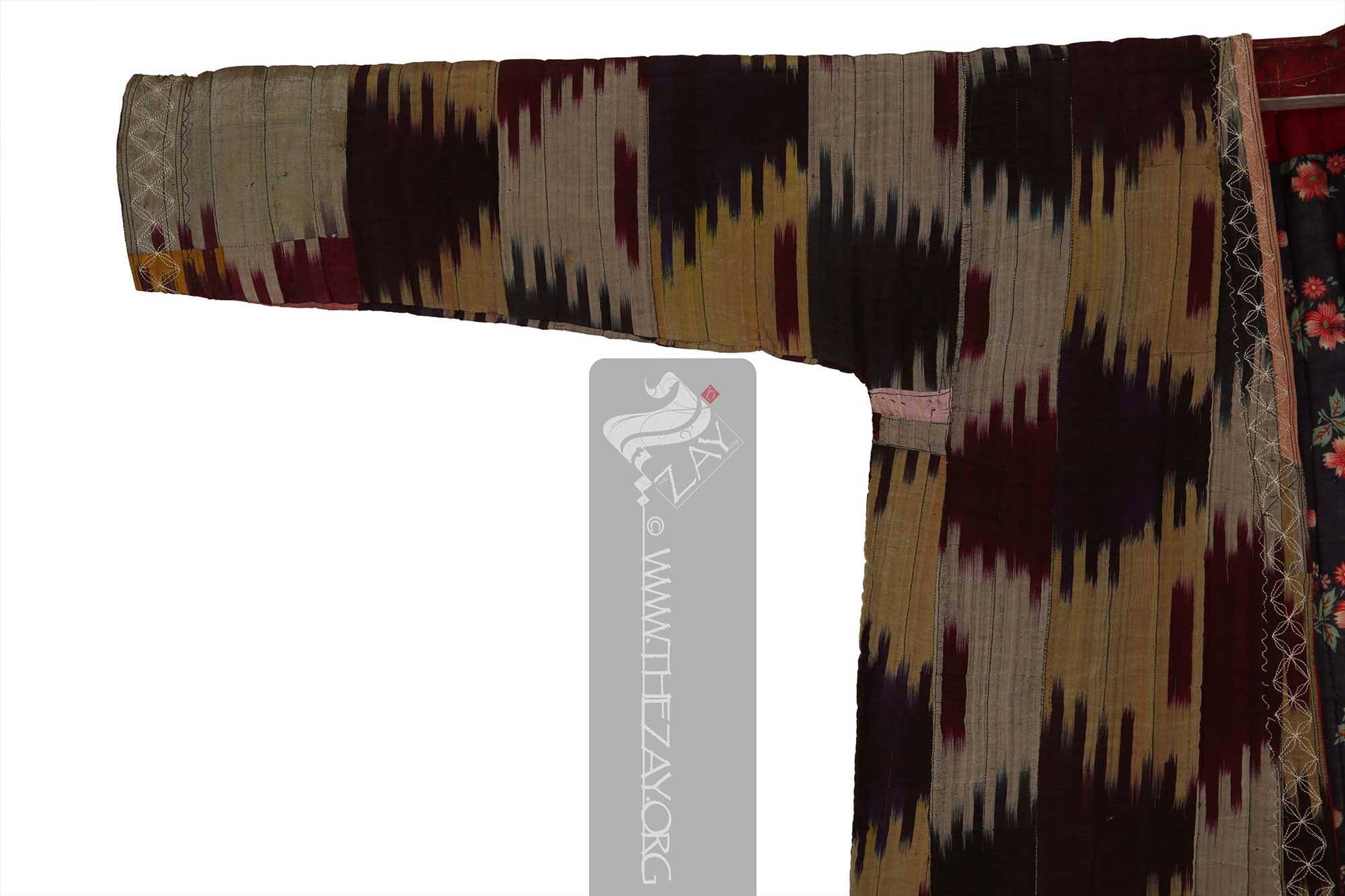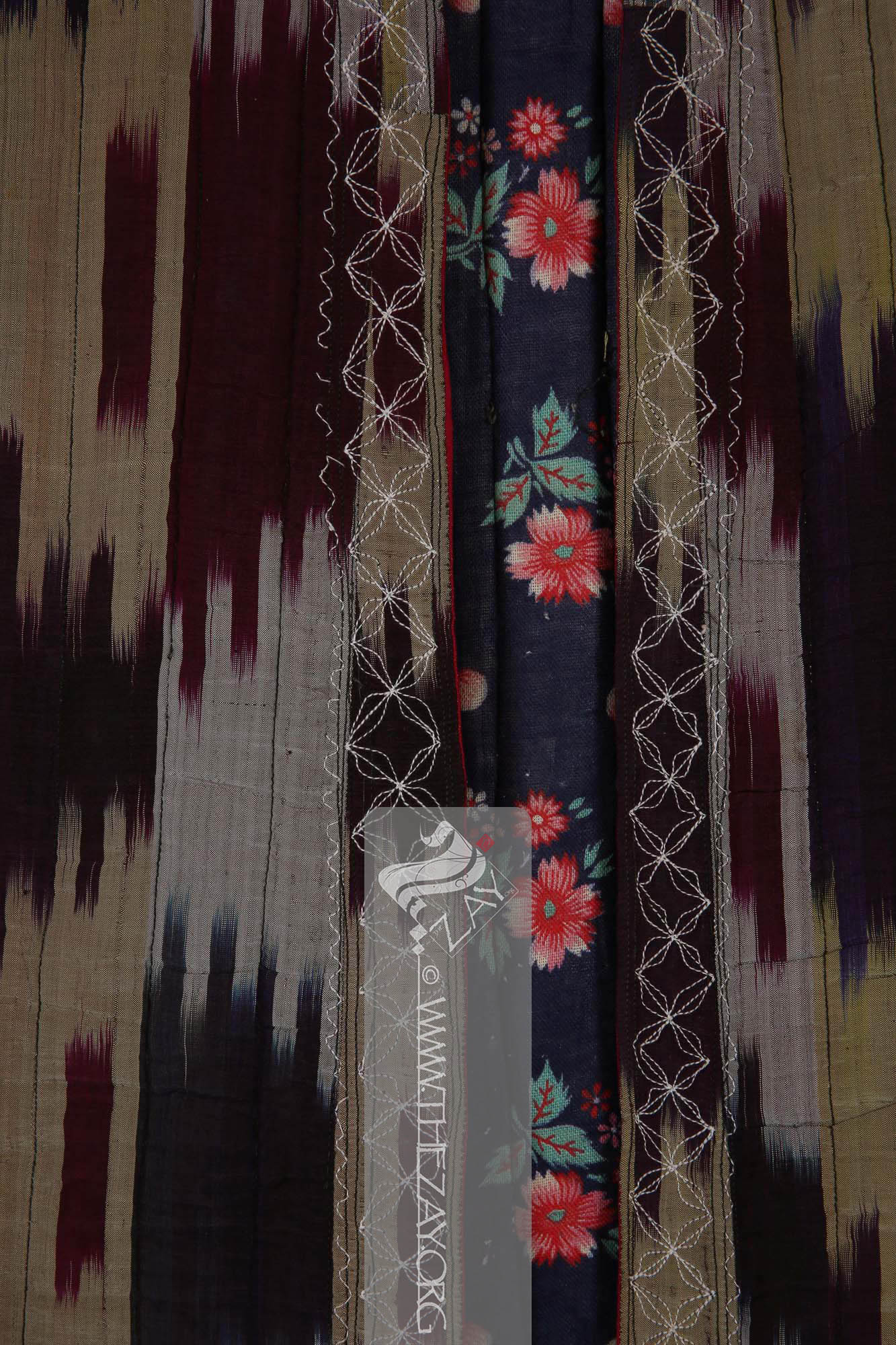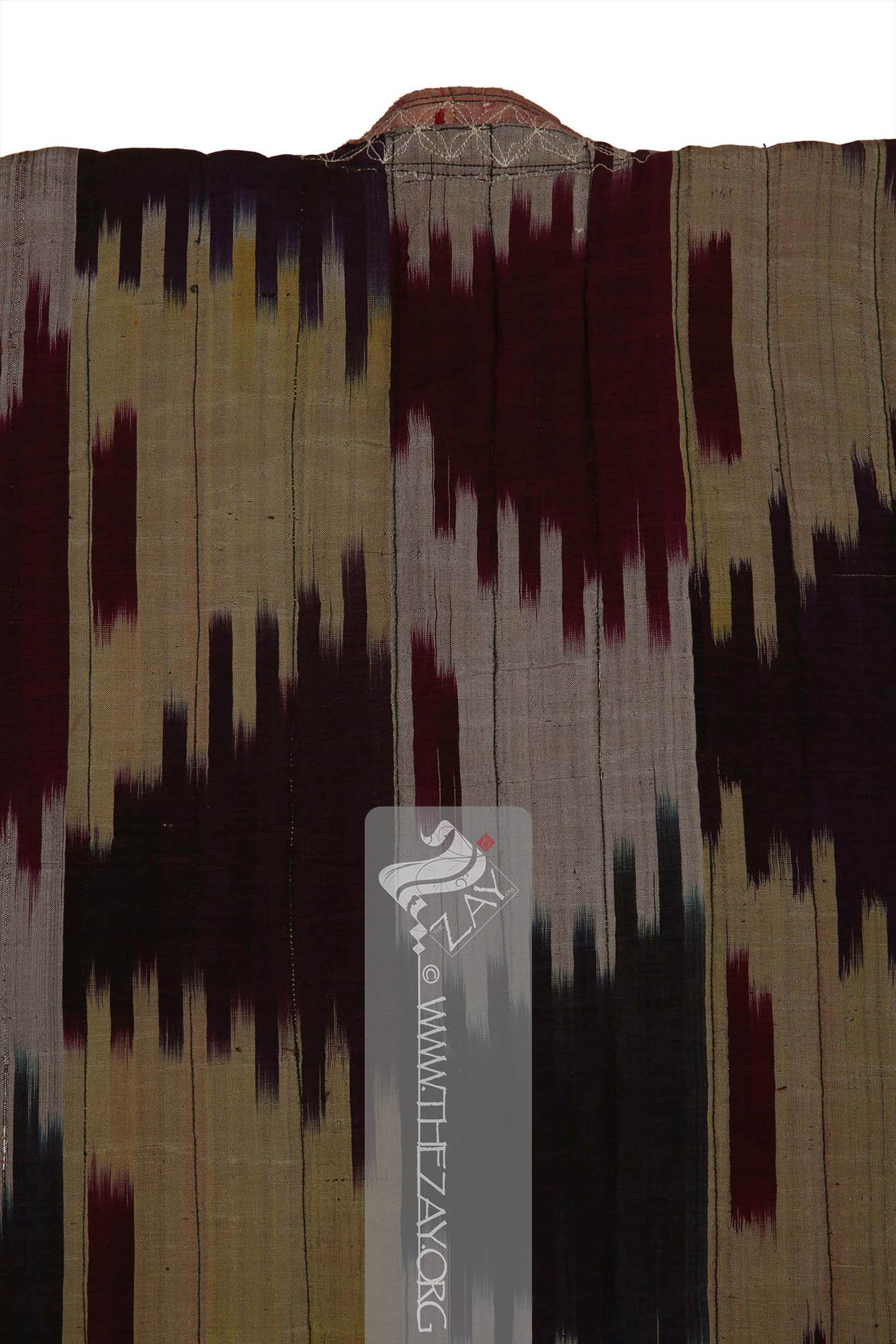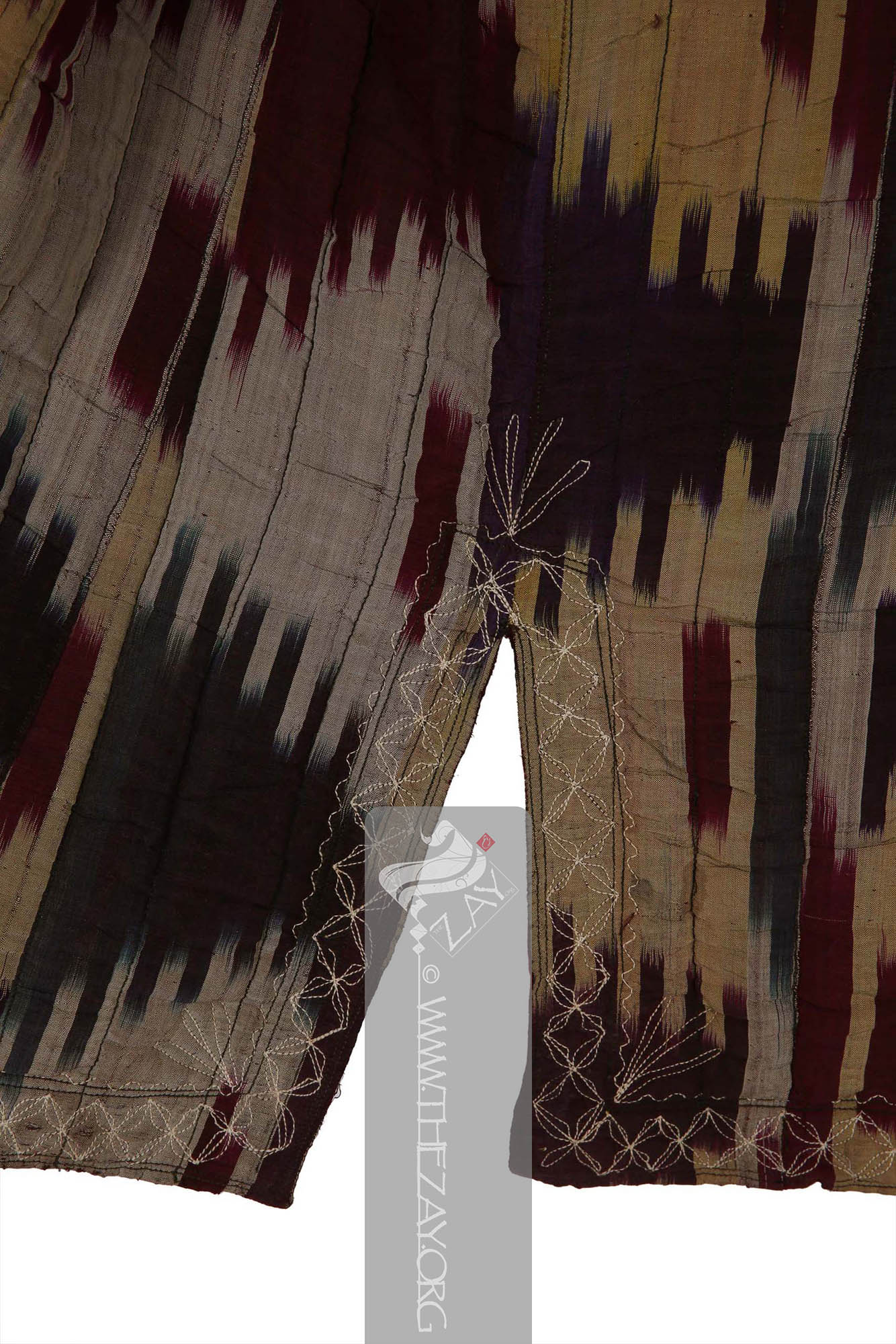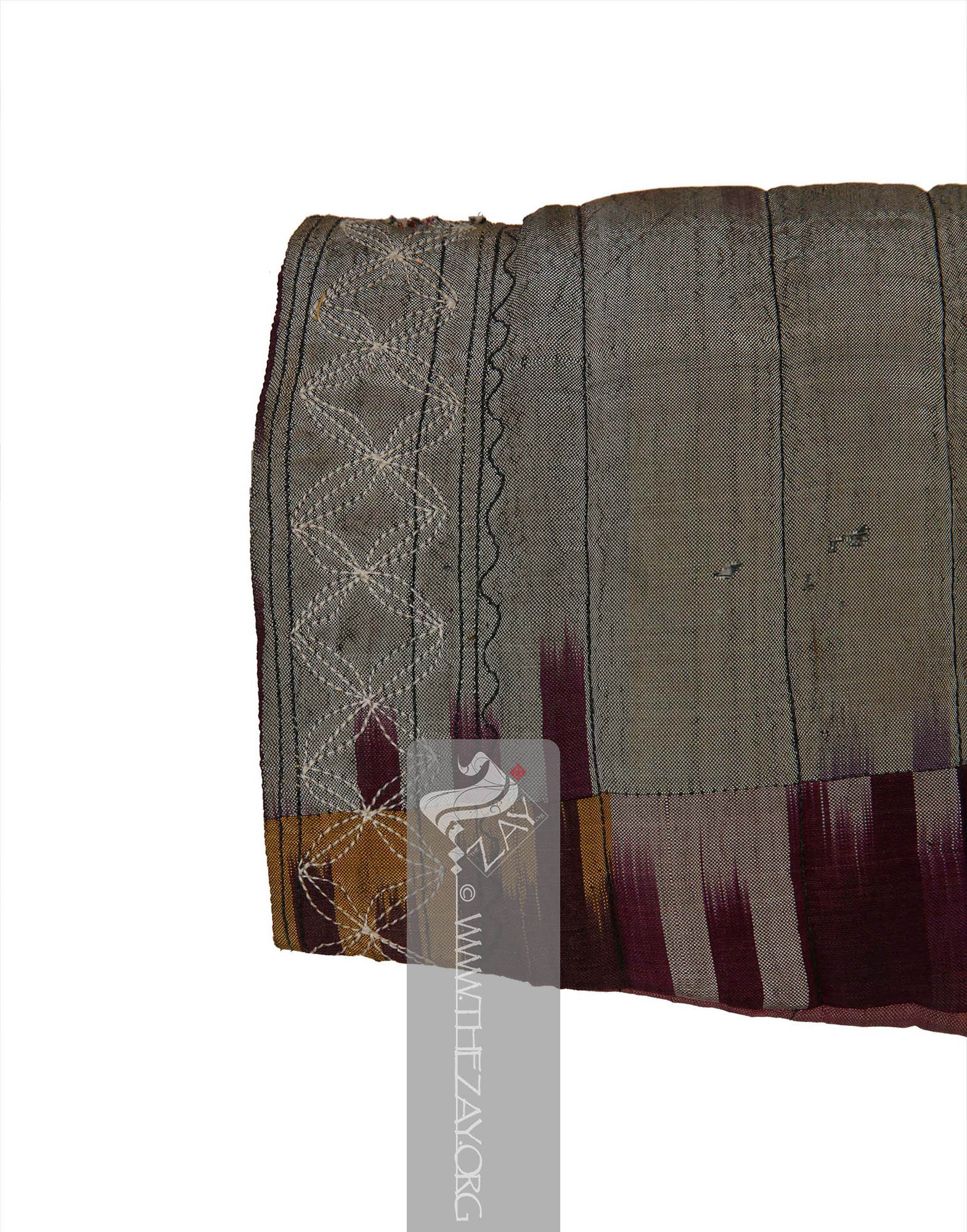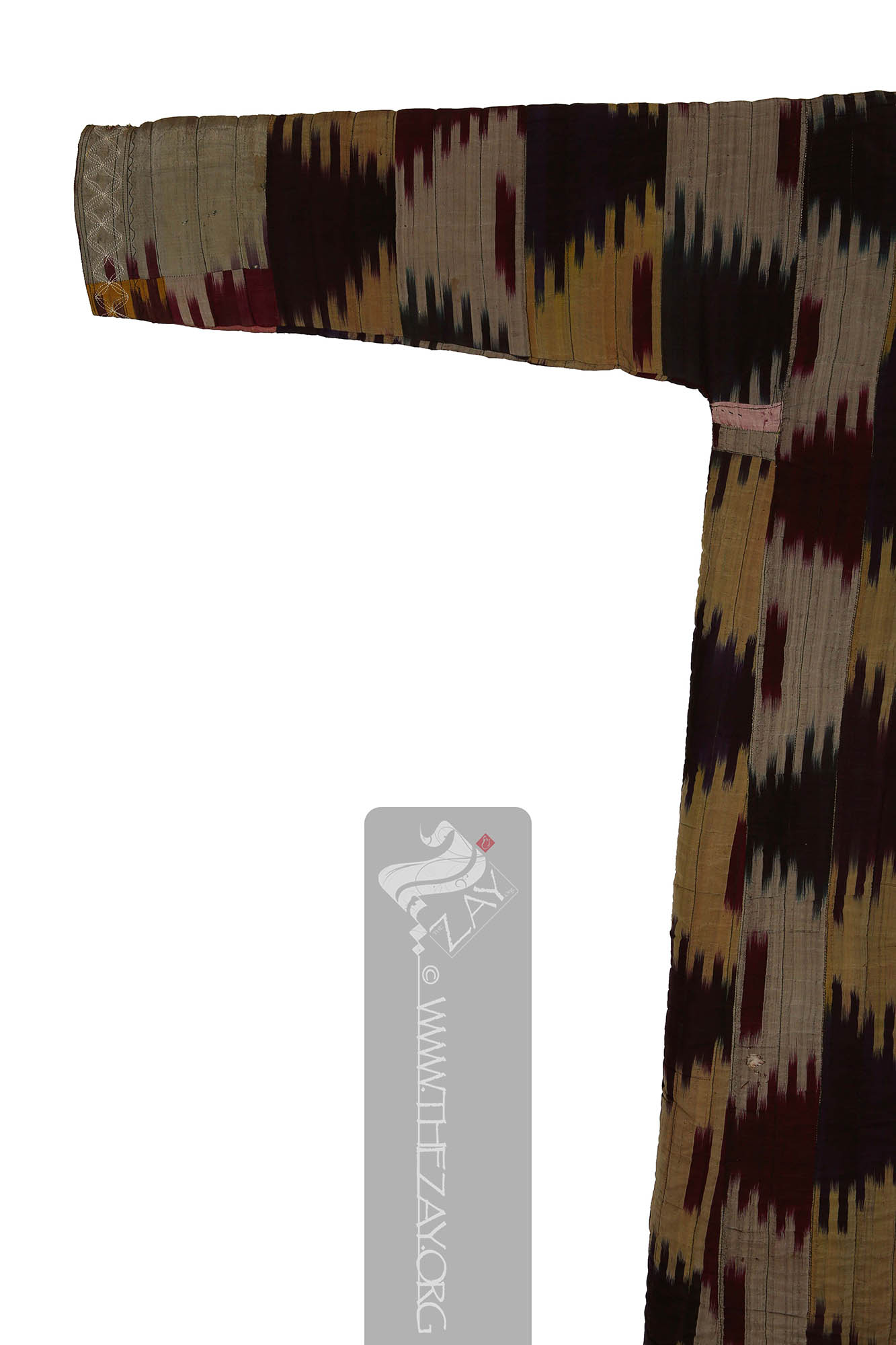Object HistoryThis beautiful and colourful woman’s traditional padded robe (
chapan
Chapan: (Persian: Chapān – old threadbare garement; or Chagatai: Chāpān, from Arabic: Jubba – Cloak; Synonym: Shapan
Shapan: (Persian: Chapān – old threadbare garment; or Chagatai: Chāpān, from Arabic: Jubba – Cloak; Synonym: Chapan), a type of traditional Central Asian robe or khalat with an open front, worn by both men and women. Usually made of silk, velvet, or cotton it is typically quilted or padded.
), a type of traditional Central Asian robe or khalat
Khalat: (Arabic: khala’a – to take off, or robe of honour; Synonym: Khil’ah), a traditional Central Asian coat with a simple construction featuring long sleeves, open front, and a flared hem. It has been worn since ancient times by men and women in various forms across the region. with open front, worn by both men and women. Usually made of silk, velvet, or cotton it is typically quilted or padded.
) was purchased by
Dr. Reem Tariq
Ṭariq: (Arabic; Synonym: tulle_bi_talli
Tūlle_bi_tallī: (French: Tulle – a city in France where fine material for veil was first made; Turkish: tel – wire; Synonym: tariq; talli; badla; khus_dozi ), series of small metal knots made on a woven net ground as embellishment. The term is commonly used in the North African Arab region specifically in Egypt.
; talli; badla; khus_dozi ), series of small metal knots made on a woven net ground as embellishment. The term is commonly used in the Levant Arab region specifically in Lebanon.
El Mutwalli
Dr. Reem Tariq
Ṭariq: (Arabic; Synonym: tulle_bi_talli
Tūlle_bi_tallī: (French: Tulle – a city in France where fine material for veil was first made; Turkish: tel – wire; Synonym: tariq; talli; badla; khus_dozi ), series of small metal knots made on a woven net ground as embellishment. The term is commonly used in the North African Arab region specifically in Egypt.
; talli; badla; khus_dozi ), series of small metal knots made on a woven net ground as embellishment. The term is commonly used in the Levant Arab region specifically in Lebanon.
el Mutwallī: Founder (CEO) of the Zay
Zay: (Arabic: costume, Pl. azyaā’), a set of clothes in a style typical of a particular country or historical period. Initiative, a public figure, speaker and author. An expert curator and consultant in Islamic art and architecture, interior design, historic costume, and UAE heritage. from an independent dealer in New York in 1998. It was eventually added to The
Zay
Zay: (Arabic: costume, Pl. azyaā’), a set of clothes in a style typical of a particular country or historical period. Initiative to enhance its collection.
Object Features This is a women’s silk (
ikat
Ikat: (Indonesian and Malay: Chord, thread, bundle; Synonym: atlas, adras), is a resist dyeing technique that involves tying and dyeing yarns or threads before weaving, resulting in a distinct pattern. With strong traditions in Southeast Asia, Central Asia, the Indian subcontinent and Central America it probably originated independently around the world. )
chapan
Chapan: (Persian: Chapān – old threadbare garement; or Chagatai: Chāpān, from Arabic: Jubba – Cloak; Synonym: Shapan
Shapan: (Persian: Chapān – old threadbare garment; or Chagatai: Chāpān, from Arabic: Jubba – Cloak; Synonym: Chapan), a type of traditional Central Asian robe or khalat with an open front, worn by both men and women. Usually made of silk, velvet, or cotton it is typically quilted or padded.
), a type of traditional Central Asian robe or khalat
Khalat: (Arabic: khala’a – to take off, or robe of honour; Synonym: Khil’ah), a traditional Central Asian coat with a simple construction featuring long sleeves, open front, and a flared hem. It has been worn since ancient times by men and women in various forms across the region. with open front, worn by both men and women. Usually made of silk, velvet, or cotton it is typically quilted or padded.
in purple, beige, yellow, aubergine and (
indigo
Indigo: (Latin: Indigo – India, synonym: nil
Nīl: (Latin: indigo), Arabised term for Indigo, a natural dye belonging to the ‘Indigofera Tinctoria’ species of plants that have been cultivated in East Asia, Egypt, India, and Peru since antiquity. According to Pliny the Elder, it was named after India as it was the source of the dye.), a natural dye belonging to the ‘Indigofera Tinctoria’ species of plants that has been cultivated in East Asia, Egypt, India, and Peru since antiquity. According to Pliny the Elder, it was named after India as it was the source of the dye. ) blue. It is lightly padded with a thin layer of (
batting
Batting: A layer of padding between two layers of fabric used in garments, typically in quilting or outerwear to provide warmth, structure, and body to the garment.) made of fine cotton held together with simple quilting style run stitches.
The hems of the
chapan
Chapan: (Persian: Chapān – old threadbare garement; or Chagatai: Chāpān, from Arabic: Jubba – Cloak; Synonym: Shapan
Shapan: (Persian: Chapān – old threadbare garment; or Chagatai: Chāpān, from Arabic: Jubba – Cloak; Synonym: Chapan), a type of traditional Central Asian robe or khalat with an open front, worn by both men and women. Usually made of silk, velvet, or cotton it is typically quilted or padded.
), a type of traditional Central Asian robe or khalat
Khalat: (Arabic: khala’a – to take off, or robe of honour; Synonym: Khil’ah), a traditional Central Asian coat with a simple construction featuring long sleeves, open front, and a flared hem. It has been worn since ancient times by men and women in various forms across the region. with open front, worn by both men and women. Usually made of silk, velvet, or cotton it is typically quilted or padded.
have border embroidery in quilting stitch style in what looks like beige cotton threads, which may have discoloured from plain ivory threads over the years. The embroidery has repeated floral motifs with corner foliage.
The piece is lined with two different cotton fabrics. The primary field is lined with an
indigo
Indigo: (Latin: Indigo – India, synonym: nil
Nīl: (Latin: indigo), Arabised term for Indigo, a natural dye belonging to the ‘Indigofera Tinctoria’ species of plants that have been cultivated in East Asia, Egypt, India, and Peru since antiquity. According to Pliny the Elder, it was named after India as it was the source of the dye.), a natural dye belonging to the ‘Indigofera Tinctoria’ species of plants that has been cultivated in East Asia, Egypt, India, and Peru since antiquity. According to Pliny the Elder, it was named after India as it was the source of the dye. blue fabric with repeats of floral bouquets in pink, yellow, red, ivory and green alternated with a rounded berry-like fruit motif also in ivory, and pink with a touch of green.
The main field's sleeves and border are lined with a plain (
crimson
Crimson: (Persian/Arabic and Turkish: qirmiz or kirmiz – red), is a vivid red color originally made from the dried bodies of a scale insect of the Kermes genus native to the Mediterranean region and was used as a dye for clothing and textiles.) red cotton fabric. The hem of the lining too has similar floral embroidery as on the outside but in black thread. The piece has slits on the two sides for easy movement and riding. One of the cuffs has a distinct yellow patch of (
warp
Warp: One of the two basic components used in weaving which transforms thread or yarns to a piece of fabric. The warp is the set of yarns stretched longitudinally in place on a loom before the weft
Weft: one of the two basic components used in weaving that transforms thread or yarns into a piece of fabric. It is the crosswise thread on a loom that is passed over and under the warp threads. is introduced during the weaving process. )
ikat
Ikat: (Indonesian and Malay: Chord, thread, bundle; Synonym: atlas, adras), is a resist dyeing technique that involves tying and dyeing yarns or threads before weaving, resulting in a distinct pattern. With strong traditions in Southeast Asia, Central Asia, the Indian subcontinent and Central America it probably originated independently around the world. threads.
While a small tear on the front left silk
ikat
Ikat: (Indonesian and Malay: Chord, thread, bundle; Synonym: atlas, adras), is a resist dyeing technique that involves tying and dyeing yarns or threads before weaving, resulting in a distinct pattern. With strong traditions in Southeast Asia, Central Asia, the Indian subcontinent and Central America it probably originated independently around the world. layer of the
chapan
Chapan: (Persian: Chapān – old threadbare garement; or Chagatai: Chāpān, from Arabic: Jubba – Cloak; Synonym: Shapan
Shapan: (Persian: Chapān – old threadbare garment; or Chagatai: Chāpān, from Arabic: Jubba – Cloak; Synonym: Chapan), a type of traditional Central Asian robe or khalat with an open front, worn by both men and women. Usually made of silk, velvet, or cotton it is typically quilted or padded.
), a type of traditional Central Asian robe or khalat
Khalat: (Arabic: khala’a – to take off, or robe of honour; Synonym: Khil’ah), a traditional Central Asian coat with a simple construction featuring long sleeves, open front, and a flared hem. It has been worn since ancient times by men and women in various forms across the region. with open front, worn by both men and women. Usually made of silk, velvet, or cotton it is typically quilted or padded.
remains unrepaired, a small rectangular yellow
ikat
Ikat: (Indonesian and Malay: Chord, thread, bundle; Synonym: atlas, adras), is a resist dyeing technique that involves tying and dyeing yarns or threads before weaving, resulting in a distinct pattern. With strong traditions in Southeast Asia, Central Asia, the Indian subcontinent and Central America it probably originated independently around the world. patch on the back has been sewn as an attempt to darn previous damage. Although the colour from the piece has bled in several places testifying to its usage over the years, it still retains its brightness, vibrancy and sheen.
A Central Asian robe or
khalat
Khalat: (Arabic: khala’a – to take off, or robe of honour; Synonym: Khil’ah), a traditional Central Asian coat with a simple construction featuring long sleeves, open front, and a flared hem. It has been worn since ancient times by men and women in various forms across the region. like this is very common around the old Silk Road. It travelled through India and Iran to the Middle East and through Ottoman Turkey as far as Russia and Romania. In medieval times richly decorated robes or
khalat
Khalat: (Arabic: khala’a – to take off, or robe of honour; Synonym: Khil’ah), a traditional Central Asian coat with a simple construction featuring long sleeves, open front, and a flared hem. It has been worn since ancient times by men and women in various forms across the region. were given as honorific gifts in India a tradition that was borrowed and continued by the British through the Colonial times when khilat a derivative of
khalat
Khalat: (Arabic: khala’a – to take off, or robe of honour; Synonym: Khil’ah), a traditional Central Asian coat with a simple construction featuring long sleeves, open front, and a flared hem. It has been worn since ancient times by men and women in various forms across the region. was used as any gift of money or goods bestowed by the British East India Company.
Similarly, the word has been burrowed in modern Russian to mean any robe, while in Romania a derivative halat is used for garments such as smocks, bathrobes, and dressing gowns. Similarly, the Yiddish and the Ashkenazi Jewish community use another derivative khlat which refers to loose long coats with (
shawl
Shawl: (Persian: shāl from Hindi: duśālā – Shoulder Mantle), a shawl is a South Asian version of a scarf worn or wrapped loosely over the shoulders and is usually made of wool. ) collars.
It is also worth noting that these Central Asian long loose robes were often made of or had lining in silk (
ikat
Ikat: (Indonesian and Malay: Chord, thread, bundle; Synonym: atlas, adras), is a resist dyeing technique that involves tying and dyeing yarns or threads before weaving, resulting in a distinct pattern. With strong traditions in Southeast Asia, Central Asia, the Indian subcontinent and Central America it probably originated independently around the world. ) fabric also known as (
adras
Adras: (Arabic and Aramaic: atlas
Aṭlas: (Latin: Atticus Atlas – a large silk producing moth; from Greek: Atlas – character from Greek mythology; Synonym: harir
Ḥarīr: (Arabic, Synonym: aṭlas), a common term for silk in the Arab world especially the Levant.
), common term for silk in the Arab world especially the Levant.
Atlas
Aṭlas: (Latin: Atticus Atlas – a large silk producing moth; from Greek: Atlas – character from Greek mythology; Synonym: harir
Ḥarīr: (Arabic, Synonym: aṭlas), a common term for silk in the Arab world especially the Levant.
), common term for silk in the Arab world especially the Levant.
: (Arabic and Aramaic: atlas
Aṭlas: (Latin: Atticus Atlas – a large silk producing moth; from Greek: Atlas – character from Greek mythology; Synonym: harir
Ḥarīr: (Arabic, Synonym: aṭlas), a common term for silk in the Arab world especially the Levant.
), common term for silk in the Arab world especially the Levant.
– silk; from Greek: Atlas
Aṭlas: (Latin: Atticus Atlas – a large silk producing moth; from Greek: Atlas – character from Greek mythology; Synonym: harir
Ḥarīr: (Arabic, Synonym: aṭlas), a common term for silk in the Arab world especially the Levant.
), common term for silk in the Arab world especially the Levant.
– Character from Greek mythology Synonym: adras, ikat
Ikat: (Indonesian and Malay: Chord, thread, bundle; Synonym: atlas, adras), is a resist dyeing technique that involves tying and dyeing yarns or threads before weaving, resulting in a distinct pattern. With strong traditions in Southeast Asia, Central Asia, the Indian subcontinent and Central America it probably originated independently around the world. , abr), a resist dyeing technique that involves tying and dyeing yarns or threads before weaving, resulting in a distinct pattern. With strong traditions sporadically across the globe it probably originated independently around the world. – silk; from Greek: Atlas
Aṭlas: (Latin: Atticus Atlas – a large silk producing moth; from Greek: Atlas – character from Greek mythology; Synonym: harir
Ḥarīr: (Arabic, Synonym: aṭlas), a common term for silk in the Arab world especially the Levant.
), common term for silk in the Arab world especially the Levant.
Atlas
Aṭlas: (Latin: Atticus Atlas – a large silk producing moth; from Greek: Atlas – character from Greek mythology; Synonym: harir
Ḥarīr: (Arabic, Synonym: aṭlas), a common term for silk in the Arab world especially the Levant.
), common term for silk in the Arab world especially the Levant.
: (Arabic and Aramaic: atlas
Aṭlas: (Latin: Atticus Atlas – a large silk producing moth; from Greek: Atlas – character from Greek mythology; Synonym: harir
Ḥarīr: (Arabic, Synonym: aṭlas), a common term for silk in the Arab world especially the Levant.
), common term for silk in the Arab world especially the Levant.
– silk; from Greek: Atlas
Aṭlas: (Latin: Atticus Atlas – a large silk producing moth; from Greek: Atlas – character from Greek mythology; Synonym: harir
Ḥarīr: (Arabic, Synonym: aṭlas), a common term for silk in the Arab world especially the Levant.
), common term for silk in the Arab world especially the Levant.
– Character from Greek mythology Synonym: adras, ikat
Ikat: (Indonesian and Malay: Chord, thread, bundle; Synonym: atlas, adras), is a resist dyeing technique that involves tying and dyeing yarns or threads before weaving, resulting in a distinct pattern. With strong traditions in Southeast Asia, Central Asia, the Indian subcontinent and Central America it probably originated independently around the world. , abr), a resist dyeing technique that involves tying and dyeing yarns or threads before weaving, resulting in a distinct pattern. With strong traditions sporadically across the globe it probably originated independently around the world. – Character from Greek mythology Synonym: atlas
Aṭlas: (Latin: Atticus Atlas – a large silk producing moth; from Greek: Atlas – character from Greek mythology; Synonym: harir
Ḥarīr: (Arabic, Synonym: aṭlas), a common term for silk in the Arab world especially the Levant.
), common term for silk in the Arab world especially the Levant.
Atlas
Aṭlas: (Latin: Atticus Atlas – a large silk producing moth; from Greek: Atlas – character from Greek mythology; Synonym: harir
Ḥarīr: (Arabic, Synonym: aṭlas), a common term for silk in the Arab world especially the Levant.
), common term for silk in the Arab world especially the Levant.
: (Arabic and Aramaic: atlas
Aṭlas: (Latin: Atticus Atlas – a large silk producing moth; from Greek: Atlas – character from Greek mythology; Synonym: harir
Ḥarīr: (Arabic, Synonym: aṭlas), a common term for silk in the Arab world especially the Levant.
), common term for silk in the Arab world especially the Levant.
– silk; from Greek: Atlas
Aṭlas: (Latin: Atticus Atlas – a large silk producing moth; from Greek: Atlas – character from Greek mythology; Synonym: harir
Ḥarīr: (Arabic, Synonym: aṭlas), a common term for silk in the Arab world especially the Levant.
), common term for silk in the Arab world especially the Levant.
– Character from Greek mythology Synonym: adras, ikat
Ikat: (Indonesian and Malay: Chord, thread, bundle; Synonym: atlas, adras), is a resist dyeing technique that involves tying and dyeing yarns or threads before weaving, resulting in a distinct pattern. With strong traditions in Southeast Asia, Central Asia, the Indian subcontinent and Central America it probably originated independently around the world. , abr), a resist dyeing technique that involves tying and dyeing yarns or threads before weaving, resulting in a distinct pattern. With strong traditions sporadically across the globe it probably originated independently around the world. , ikat
Ikat: (Indonesian and Malay: Chord, thread, bundle; Synonym: atlas, adras), is a resist dyeing technique that involves tying and dyeing yarns or threads before weaving, resulting in a distinct pattern. With strong traditions in Southeast Asia, Central Asia, the Indian subcontinent and Central America it probably originated independently around the world. , abr), a resist dyeing technique that involves tying and dyeing yarns or threads before weaving, resulting in a distinct pattern. With strong traditions sporadically across the globe it probably originated independently around the world. ) or (
atlas
Aṭlas: (Latin: Atticus Atlas – a large silk producing moth; from Greek: Atlas – character from Greek mythology; Synonym: harir
Ḥarīr: (Arabic, Synonym: aṭlas), a common term for silk in the Arab world especially the Levant.
), common term for silk in the Arab world especially the Levant.
Atlas
Aṭlas: (Latin: Atticus Atlas – a large silk producing moth; from Greek: Atlas – character from Greek mythology; Synonym: harir
Ḥarīr: (Arabic, Synonym: aṭlas), a common term for silk in the Arab world especially the Levant.
), common term for silk in the Arab world especially the Levant.
: (Arabic and Aramaic: atlas
Aṭlas: (Latin: Atticus Atlas – a large silk producing moth; from Greek: Atlas – character from Greek mythology; Synonym: harir
Ḥarīr: (Arabic, Synonym: aṭlas), a common term for silk in the Arab world especially the Levant.
), common term for silk in the Arab world especially the Levant.
– silk; from Greek: Atlas
Aṭlas: (Latin: Atticus Atlas – a large silk producing moth; from Greek: Atlas – character from Greek mythology; Synonym: harir
Ḥarīr: (Arabic, Synonym: aṭlas), a common term for silk in the Arab world especially the Levant.
), common term for silk in the Arab world especially the Levant.
– Character from Greek mythology Synonym: adras, ikat
Ikat: (Indonesian and Malay: Chord, thread, bundle; Synonym: atlas, adras), is a resist dyeing technique that involves tying and dyeing yarns or threads before weaving, resulting in a distinct pattern. With strong traditions in Southeast Asia, Central Asia, the Indian subcontinent and Central America it probably originated independently around the world. , abr), a resist dyeing technique that involves tying and dyeing yarns or threads before weaving, resulting in a distinct pattern. With strong traditions sporadically across the globe it probably originated independently around the world. ) in Central Asian and Uyghur Turkic respectively.
Usually, silk was cultivated by every household in Central Asia, however, the silk yarn dyeing industry was primarily dominated by the Jewish community of Central Asia.
More InfoCentral Asian
ikat
Ikat: (Indonesian and Malay: Chord, thread, bundle; Synonym: atlas, adras), is a resist dyeing technique that involves tying and dyeing yarns or threads before weaving, resulting in a distinct pattern. With strong traditions in Southeast Asia, Central Asia, the Indian subcontinent and Central America it probably originated independently around the world. are traditionally (
warp
Warp: One of the two basic components used in weaving which transforms thread or yarns to a piece of fabric. The warp is the set of yarns stretched longitudinally in place on a loom before the weft
Weft: one of the two basic components used in weaving that transforms thread or yarns into a piece of fabric. It is the crosswise thread on a loom that is passed over and under the warp threads. is introduced during the weaving process. )
ikat
Ikat: (Indonesian and Malay: Chord, thread, bundle; Synonym: atlas, adras), is a resist dyeing technique that involves tying and dyeing yarns or threads before weaving, resulting in a distinct pattern. With strong traditions in Southeast Asia, Central Asia, the Indian subcontinent and Central America it probably originated independently around the world. which means they have silk warps with intricate patterns held together by cotton (wefts). These ikats were made in established locations and required the contribution of at least 13 specialised craftspeople. Among them were designers or pattern makers, who drew patterns on the warps, makers of hot and cold dyes, expert resist dyers, loom builders, workers who arranged and adjusted the warps on the loom, and weavers who created the final material.
The fact that these crafts were often organised into guilds and comprised of diverse ethnic groups meant that the completion of a single
ikat
Ikat: (Indonesian and Malay: Chord, thread, bundle; Synonym: atlas, adras), is a resist dyeing technique that involves tying and dyeing yarns or threads before weaving, resulting in a distinct pattern. With strong traditions in Southeast Asia, Central Asia, the Indian subcontinent and Central America it probably originated independently around the world. fabric was a remarkable feat of occupational and ethnic cooperation.
Amongst the Uyghurs (
atlas
Aṭlas: (Latin: Atticus Atlas – a large silk producing moth; from Greek: Atlas – character from Greek mythology; Synonym: harir
Ḥarīr: (Arabic, Synonym: aṭlas), a common term for silk in the Arab world especially the Levant.
), common term for silk in the Arab world especially the Levant.
Atlas
Aṭlas: (Latin: Atticus Atlas – a large silk producing moth; from Greek: Atlas – character from Greek mythology; Synonym: harir
Ḥarīr: (Arabic, Synonym: aṭlas), a common term for silk in the Arab world especially the Levant.
), common term for silk in the Arab world especially the Levant.
: (Arabic and Aramaic: atlas
Aṭlas: (Latin: Atticus Atlas – a large silk producing moth; from Greek: Atlas – character from Greek mythology; Synonym: harir
Ḥarīr: (Arabic, Synonym: aṭlas), a common term for silk in the Arab world especially the Levant.
), common term for silk in the Arab world especially the Levant.
– silk; from Greek: Atlas
Aṭlas: (Latin: Atticus Atlas – a large silk producing moth; from Greek: Atlas – character from Greek mythology; Synonym: harir
Ḥarīr: (Arabic, Synonym: aṭlas), a common term for silk in the Arab world especially the Levant.
), common term for silk in the Arab world especially the Levant.
– Character from Greek mythology Synonym: adras, ikat
Ikat: (Indonesian and Malay: Chord, thread, bundle; Synonym: atlas, adras), is a resist dyeing technique that involves tying and dyeing yarns or threads before weaving, resulting in a distinct pattern. With strong traditions in Southeast Asia, Central Asia, the Indian subcontinent and Central America it probably originated independently around the world. , abr), a resist dyeing technique that involves tying and dyeing yarns or threads before weaving, resulting in a distinct pattern. With strong traditions sporadically across the globe it probably originated independently around the world. ) or
ikat
Ikat: (Indonesian and Malay: Chord, thread, bundle; Synonym: atlas, adras), is a resist dyeing technique that involves tying and dyeing yarns or threads before weaving, resulting in a distinct pattern. With strong traditions in Southeast Asia, Central Asia, the Indian subcontinent and Central America it probably originated independently around the world. was used exclusively for women's clothing. Historically there were twenty-seven types of
atlas
Aṭlas: (Latin: Atticus Atlas – a large silk producing moth; from Greek: Atlas – character from Greek mythology; Synonym: harir
Ḥarīr: (Arabic, Synonym: aṭlas), a common term for silk in the Arab world especially the Levant.
), common term for silk in the Arab world especially the Levant.
Atlas
Aṭlas: (Latin: Atticus Atlas – a large silk producing moth; from Greek: Atlas – character from Greek mythology; Synonym: harir
Ḥarīr: (Arabic, Synonym: aṭlas), a common term for silk in the Arab world especially the Levant.
), common term for silk in the Arab world especially the Levant.
: (Arabic and Aramaic: atlas
Aṭlas: (Latin: Atticus Atlas – a large silk producing moth; from Greek: Atlas – character from Greek mythology; Synonym: harir
Ḥarīr: (Arabic, Synonym: aṭlas), a common term for silk in the Arab world especially the Levant.
), common term for silk in the Arab world especially the Levant.
– silk; from Greek: Atlas
Aṭlas: (Latin: Atticus Atlas – a large silk producing moth; from Greek: Atlas – character from Greek mythology; Synonym: harir
Ḥarīr: (Arabic, Synonym: aṭlas), a common term for silk in the Arab world especially the Levant.
), common term for silk in the Arab world especially the Levant.
– Character from Greek mythology Synonym: adras, ikat
Ikat: (Indonesian and Malay: Chord, thread, bundle; Synonym: atlas, adras), is a resist dyeing technique that involves tying and dyeing yarns or threads before weaving, resulting in a distinct pattern. With strong traditions in Southeast Asia, Central Asia, the Indian subcontinent and Central America it probably originated independently around the world. , abr), a resist dyeing technique that involves tying and dyeing yarns or threads before weaving, resulting in a distinct pattern. With strong traditions sporadically across the globe it probably originated independently around the world. during the Qing Chinese occupation, out of which only four varieties exist today. These include the black
ikat
Ikat: (Indonesian and Malay: Chord, thread, bundle; Synonym: atlas, adras), is a resist dyeing technique that involves tying and dyeing yarns or threads before weaving, resulting in a distinct pattern. With strong traditions in Southeast Asia, Central Asia, the Indian subcontinent and Central America it probably originated independently around the world. – qara-
atlas
Aṭlas: (Latin: Atticus Atlas – a large silk producing moth; from Greek: Atlas – character from Greek mythology; Synonym: harir
Ḥarīr: (Arabic, Synonym: aṭlas), a common term for silk in the Arab world especially the Levant.
), common term for silk in the Arab world especially the Levant.
Atlas
Aṭlas: (Latin: Atticus Atlas – a large silk producing moth; from Greek: Atlas – character from Greek mythology; Synonym: harir
Ḥarīr: (Arabic, Synonym: aṭlas), a common term for silk in the Arab world especially the Levant.
), common term for silk in the Arab world especially the Levant.
: (Arabic and Aramaic: atlas
Aṭlas: (Latin: Atticus Atlas – a large silk producing moth; from Greek: Atlas – character from Greek mythology; Synonym: harir
Ḥarīr: (Arabic, Synonym: aṭlas), a common term for silk in the Arab world especially the Levant.
), common term for silk in the Arab world especially the Levant.
– silk; from Greek: Atlas
Aṭlas: (Latin: Atticus Atlas – a large silk producing moth; from Greek: Atlas – character from Greek mythology; Synonym: harir
Ḥarīr: (Arabic, Synonym: aṭlas), a common term for silk in the Arab world especially the Levant.
), common term for silk in the Arab world especially the Levant.
– Character from Greek mythology Synonym: adras, ikat
Ikat: (Indonesian and Malay: Chord, thread, bundle; Synonym: atlas, adras), is a resist dyeing technique that involves tying and dyeing yarns or threads before weaving, resulting in a distinct pattern. With strong traditions in Southeast Asia, Central Asia, the Indian subcontinent and Central America it probably originated independently around the world. , abr), a resist dyeing technique that involves tying and dyeing yarns or threads before weaving, resulting in a distinct pattern. With strong traditions sporadically across the globe it probably originated independently around the world. – reserved for older women; the yellow, blue or purple
ikat
Ikat: (Indonesian and Malay: Chord, thread, bundle; Synonym: atlas, adras), is a resist dyeing technique that involves tying and dyeing yarns or threads before weaving, resulting in a distinct pattern. With strong traditions in Southeast Asia, Central Asia, the Indian subcontinent and Central America it probably originated independently around the world. – khoja’e-
atlas
Aṭlas: (Latin: Atticus Atlas – a large silk producing moth; from Greek: Atlas – character from Greek mythology; Synonym: harir
Ḥarīr: (Arabic, Synonym: aṭlas), a common term for silk in the Arab world especially the Levant.
), common term for silk in the Arab world especially the Levant.
Atlas
Aṭlas: (Latin: Atticus Atlas – a large silk producing moth; from Greek: Atlas – character from Greek mythology; Synonym: harir
Ḥarīr: (Arabic, Synonym: aṭlas), a common term for silk in the Arab world especially the Levant.
), common term for silk in the Arab world especially the Levant.
: (Arabic and Aramaic: atlas
Aṭlas: (Latin: Atticus Atlas – a large silk producing moth; from Greek: Atlas – character from Greek mythology; Synonym: harir
Ḥarīr: (Arabic, Synonym: aṭlas), a common term for silk in the Arab world especially the Levant.
), common term for silk in the Arab world especially the Levant.
– silk; from Greek: Atlas
Aṭlas: (Latin: Atticus Atlas – a large silk producing moth; from Greek: Atlas – character from Greek mythology; Synonym: harir
Ḥarīr: (Arabic, Synonym: aṭlas), a common term for silk in the Arab world especially the Levant.
), common term for silk in the Arab world especially the Levant.
– Character from Greek mythology Synonym: adras, ikat
Ikat: (Indonesian and Malay: Chord, thread, bundle; Synonym: atlas, adras), is a resist dyeing technique that involves tying and dyeing yarns or threads before weaving, resulting in a distinct pattern. With strong traditions in Southeast Asia, Central Asia, the Indian subcontinent and Central America it probably originated independently around the world. , abr), a resist dyeing technique that involves tying and dyeing yarns or threads before weaving, resulting in a distinct pattern. With strong traditions sporadically across the globe it probably originated independently around the world. – worn by married women; red
ikat
Ikat: (Indonesian and Malay: Chord, thread, bundle; Synonym: atlas, adras), is a resist dyeing technique that involves tying and dyeing yarns or threads before weaving, resulting in a distinct pattern. With strong traditions in Southeast Asia, Central Asia, the Indian subcontinent and Central America it probably originated independently around the world. – qizil-
atlas
Aṭlas: (Latin: Atticus Atlas – a large silk producing moth; from Greek: Atlas – character from Greek mythology; Synonym: harir
Ḥarīr: (Arabic, Synonym: aṭlas), a common term for silk in the Arab world especially the Levant.
), common term for silk in the Arab world especially the Levant.
Atlas
Aṭlas: (Latin: Atticus Atlas – a large silk producing moth; from Greek: Atlas – character from Greek mythology; Synonym: harir
Ḥarīr: (Arabic, Synonym: aṭlas), a common term for silk in the Arab world especially the Levant.
), common term for silk in the Arab world especially the Levant.
: (Arabic and Aramaic: atlas
Aṭlas: (Latin: Atticus Atlas – a large silk producing moth; from Greek: Atlas – character from Greek mythology; Synonym: harir
Ḥarīr: (Arabic, Synonym: aṭlas), a common term for silk in the Arab world especially the Levant.
), common term for silk in the Arab world especially the Levant.
– silk; from Greek: Atlas
Aṭlas: (Latin: Atticus Atlas – a large silk producing moth; from Greek: Atlas – character from Greek mythology; Synonym: harir
Ḥarīr: (Arabic, Synonym: aṭlas), a common term for silk in the Arab world especially the Levant.
), common term for silk in the Arab world especially the Levant.
– Character from Greek mythology Synonym: adras, ikat
Ikat: (Indonesian and Malay: Chord, thread, bundle; Synonym: atlas, adras), is a resist dyeing technique that involves tying and dyeing yarns or threads before weaving, resulting in a distinct pattern. With strong traditions in Southeast Asia, Central Asia, the Indian subcontinent and Central America it probably originated independently around the world. , abr), a resist dyeing technique that involves tying and dyeing yarns or threads before weaving, resulting in a distinct pattern. With strong traditions sporadically across the globe it probably originated independently around the world. – for young girls; and the royal
ikat
Ikat: (Indonesian and Malay: Chord, thread, bundle; Synonym: atlas, adras), is a resist dyeing technique that involves tying and dyeing yarns or threads before weaving, resulting in a distinct pattern. With strong traditions in Southeast Asia, Central Asia, the Indian subcontinent and Central America it probably originated independently around the world. – Yarkent-
atlas
Aṭlas: (Latin: Atticus Atlas – a large silk producing moth; from Greek: Atlas – character from Greek mythology; Synonym: harir
Ḥarīr: (Arabic, Synonym: aṭlas), a common term for silk in the Arab world especially the Levant.
), common term for silk in the Arab world especially the Levant.
Atlas
Aṭlas: (Latin: Atticus Atlas – a large silk producing moth; from Greek: Atlas – character from Greek mythology; Synonym: harir
Ḥarīr: (Arabic, Synonym: aṭlas), a common term for silk in the Arab world especially the Levant.
), common term for silk in the Arab world especially the Levant.
: (Arabic and Aramaic: atlas
Aṭlas: (Latin: Atticus Atlas – a large silk producing moth; from Greek: Atlas – character from Greek mythology; Synonym: harir
Ḥarīr: (Arabic, Synonym: aṭlas), a common term for silk in the Arab world especially the Levant.
), common term for silk in the Arab world especially the Levant.
– silk; from Greek: Atlas
Aṭlas: (Latin: Atticus Atlas – a large silk producing moth; from Greek: Atlas – character from Greek mythology; Synonym: harir
Ḥarīr: (Arabic, Synonym: aṭlas), a common term for silk in the Arab world especially the Levant.
), common term for silk in the Arab world especially the Levant.
– Character from Greek mythology Synonym: adras, ikat
Ikat: (Indonesian and Malay: Chord, thread, bundle; Synonym: atlas, adras), is a resist dyeing technique that involves tying and dyeing yarns or threads before weaving, resulting in a distinct pattern. With strong traditions in Southeast Asia, Central Asia, the Indian subcontinent and Central America it probably originated independently around the world. , abr), a resist dyeing technique that involves tying and dyeing yarns or threads before weaving, resulting in a distinct pattern. With strong traditions sporadically across the globe it probably originated independently around the world. – which was developed during the Yarkent Khanate – 1514-1705 – and displays a wide range and styles.
Linkshttps://www.youtube.com/watch?v=AzYwTqTER9Y
- Valérie Bérinstain, Mary Hunt Kahlenberg, Zaira Mis, Marcel Mis. Asian Costumes and Textiles from the Bosphorus to Fujiyama: The Zaira and Marcel Mis Collection. California: Skira, 2001.
- Suleman, Fahmida. Textiles of the Middle East and Central Asia (British Museum) The Fabric of Life. London: Thames and Hudson, 2017.
- Embroidery from Afghanistan Fabric, folios. Sheila Paine. Washington: University of Washington Press, 2006.
- Sukhareva, Olʹga Aleksandrovna. Suzani
Suzani: (Farsi: suzandozi : needlework, from Farsi: suzan: needle, dozi: embellishment), type of embroidered and decorative Central Asian tribal textile art usually on a cotton fabric, embroidered in both silk or cotton thread with primarily chain, satin, and buttonhole stitches as well as couching technique. : Central Asian Decorative Embroidery. Samarkand: SMI Asia, 2013.
- https://rjohnhowe.wordpress.com/2009/03/25/christine-brown-on-uzbek-clothing-part-1-the-lecture/
- https://rjohnhowe.wordpress.com/2009/03/25/christine-brown-on-uzbek-clothing-part-2-material-in-the-room/
- https://unesdoc.unesco.org/ark:/48223/pf0000130205
- https://asiasociety.org/central-asia-political-history-19th-century-present
- https://referenceworks.brillonline.com/entries/encyclopaedia-iranica-online/clothing-COM_7759?lang=fr#COM-10186
- https://www.internationalwardrobe.com/lexicon-2/der-mantelchapan-in-usbekistan-2/
- https://www.internationalwardrobe.com/lexicon-2/der-mantelchapan-in-usbekistan-2/
- https://www.textile-forum-blog.org/2023/01/on-the-roads-of-samarkand-wonders-of-silk-and-gold/




